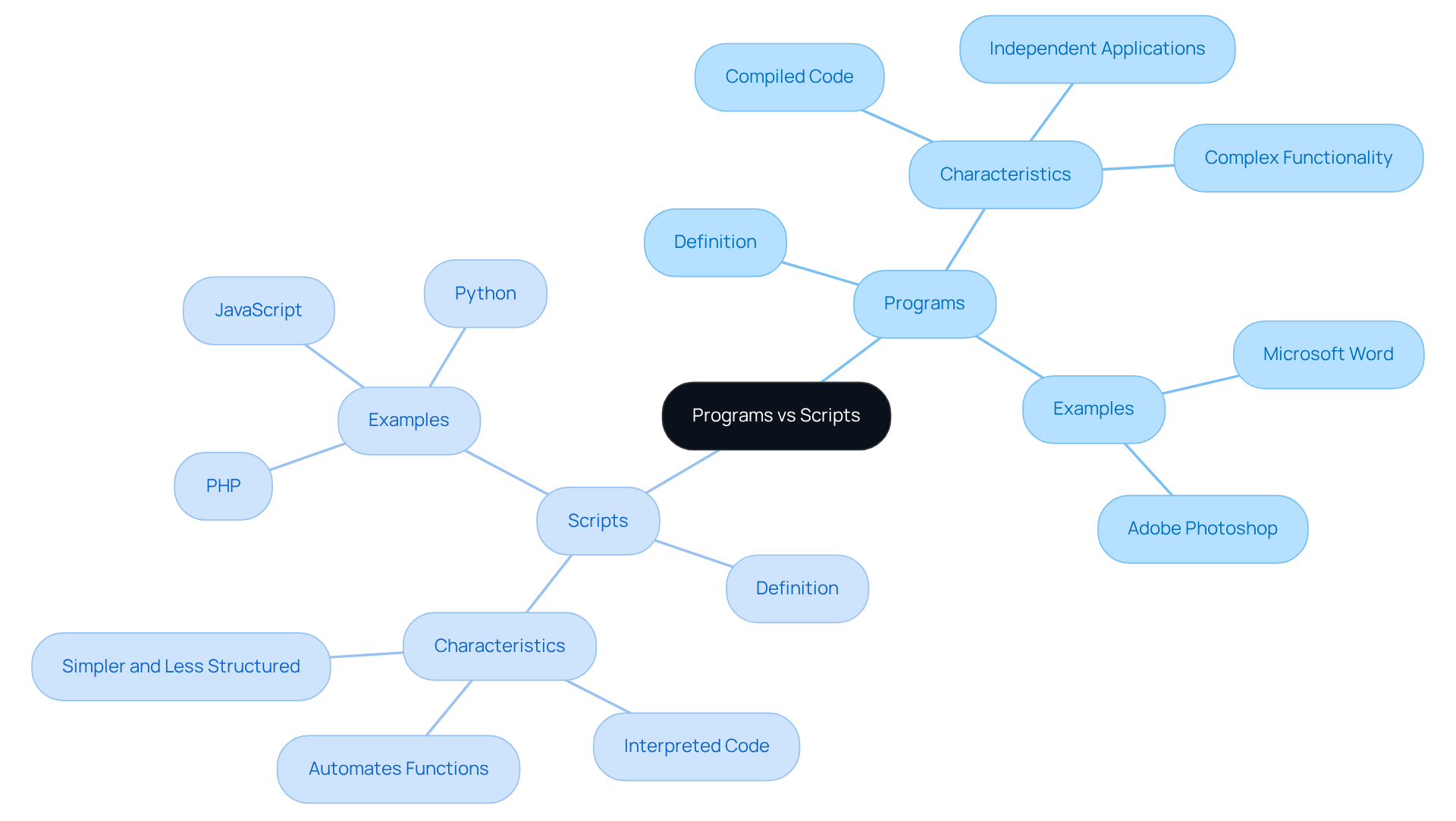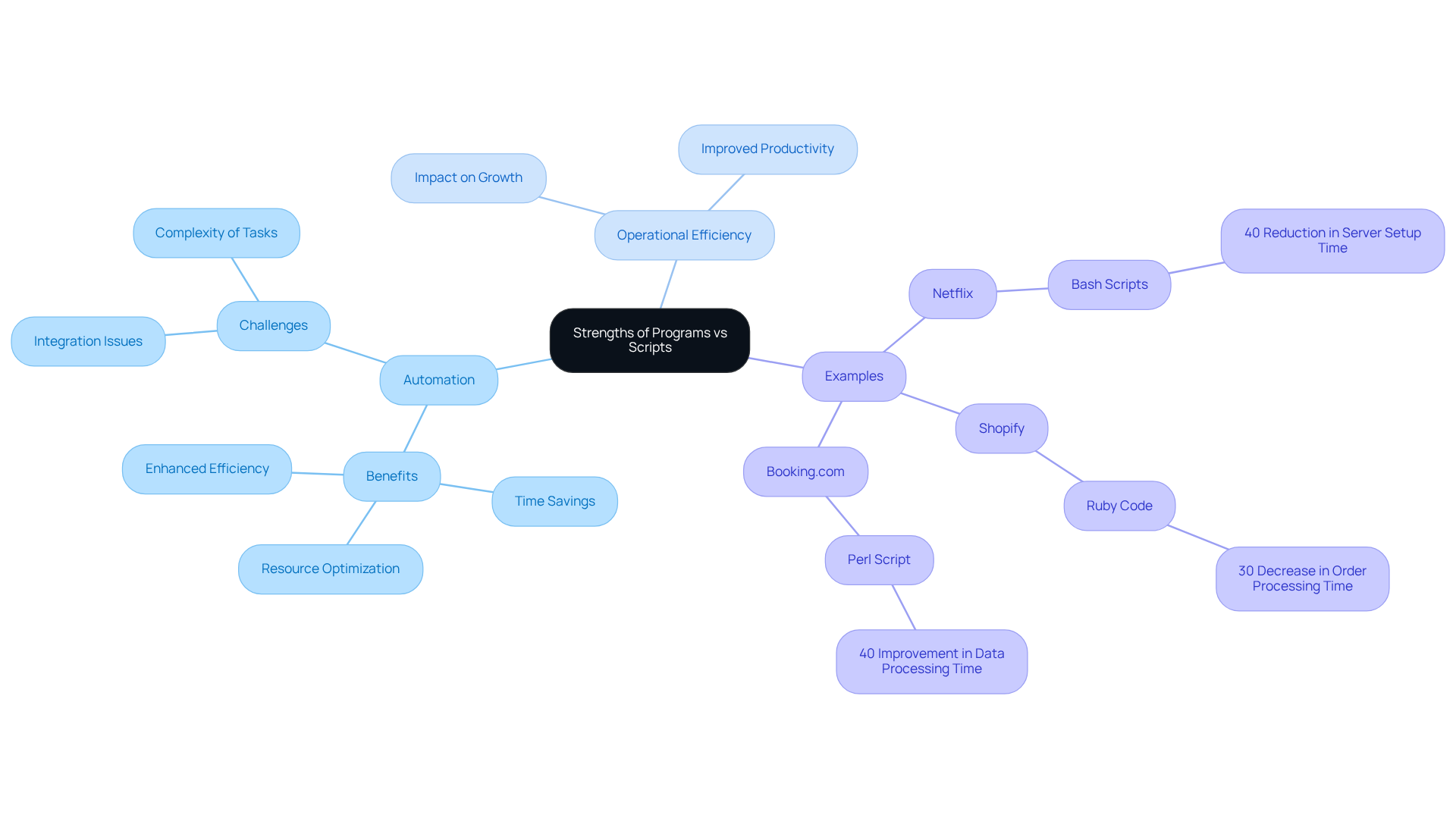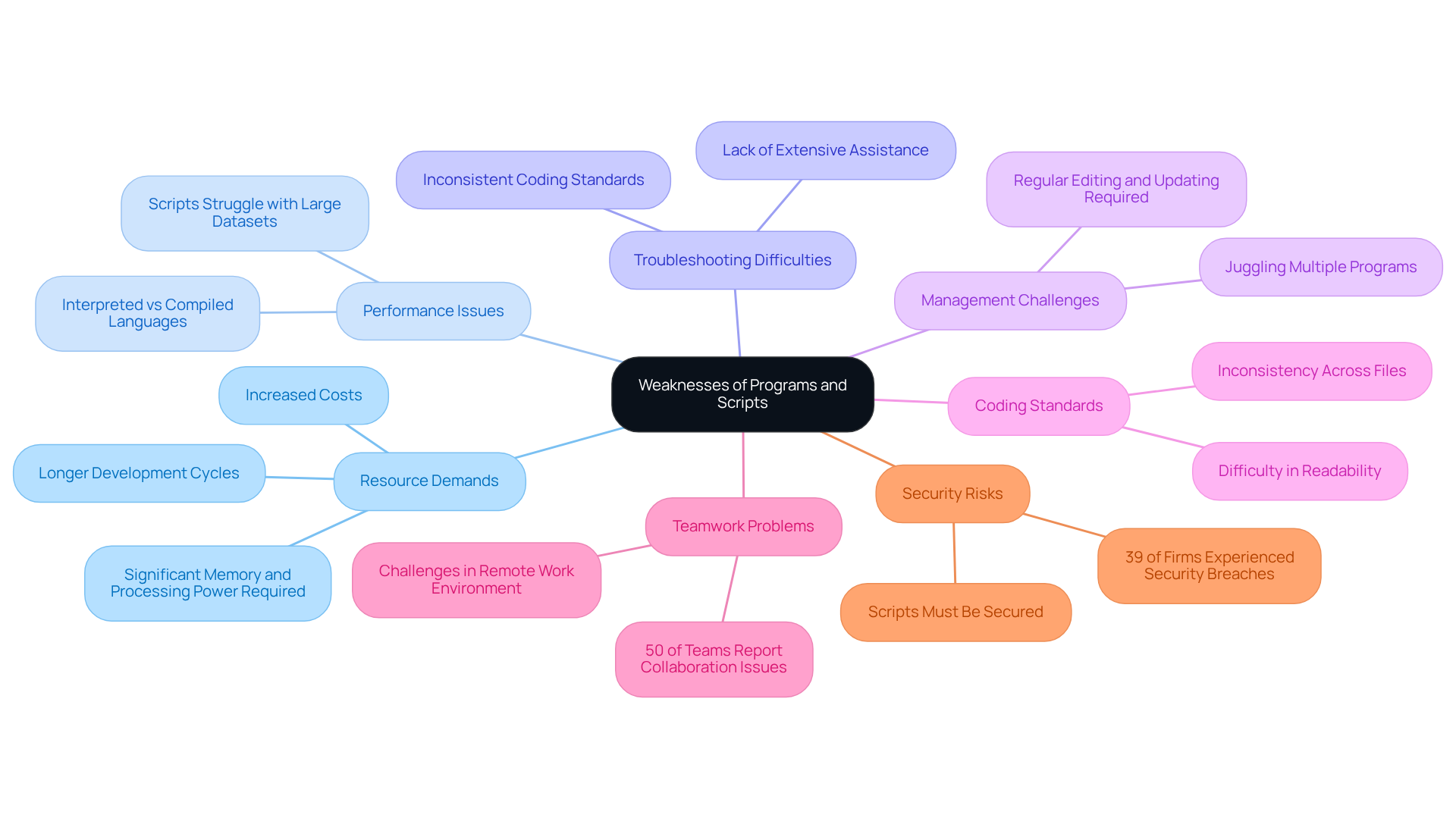Overview
In the ever-evolving world of technology, many startup founders face a common challenge: selecting the right tools for their projects. This decision can feel overwhelming, especially when considering the strengths and weaknesses of various options. Programs and scripts each serve unique purposes, yet understanding these differences is crucial for success.
Programs are complete applications designed for specific functions, excelling in handling complex tasks that require substantial resources. However, they can be daunting for those new to technology. On the other hand, scripts are smaller, interpreted codes that offer flexibility and efficiency for repetitive tasks, making them an appealing choice for automation within larger systems.
As you navigate these choices, it’s essential to reflect on your project needs. Choosing the right tool can alleviate stress and enhance productivity. Remember, it’s not just about the technology; it’s about finding what works best for you and your team. By understanding the unique strengths of programs and scripts, you can make informed decisions that empower your startup’s growth. We’re here to support you on this journey, ensuring you have the right tools to succeed.
Introduction
In the realm of software development, many developers and businesses find themselves grappling with a common dilemma: the distinction between programs and scripts. This question often stirs up a lively debate. Programs are typically seen as comprehensive applications designed for specific tasks, while scripts are nimble tools that automate functions within larger systems. This situation can lead to confusion and frustration, especially for those striving to enhance their operational efficiency. How can one navigate these complexities amidst the rapid pace of technological advancement?
As you ponder this, consider the implications of your choices. The right tool can significantly impact your organization’s workflow, yet the decision-making process can feel overwhelming. It's essential to recognize that you are not alone in this journey. Many tech startup founders share similar experiences, facing the challenge of selecting the most suitable approach for their unique needs.
But there is hope. By understanding the strengths and weaknesses of both programs and scripts, you can make informed decisions that align with your goals. Together, let’s explore how to leverage each approach effectively, ensuring that you can enhance your operational efficiency with confidence and clarity.
Defining Programs and Scripts: Core Concepts
In the ever-evolving world of technology, many developers and businesses grapple with the complexities of software development. The distinction between program vs script often highlights that programs are seen as complete, independent applications designed to perform specific functions. These applications, like Microsoft Word and Adobe Photoshop, are compiled into machine code, allowing the computer's processor to execute them directly. However, the challenge arises when we consider the smaller, interpreted segments of code that automate functions within larger systems. Written in languages such as Python, JavaScript, or PHP, these scripts are , which can feel overwhelming for those new to coding.
As Maren Vernon insightfully states, "Coding (or programming) is an umbrella term that applies to all computer languages," reminding us of the broader context of coding and its relationship to scripting. This understanding is crucial, as it influences how developers and businesses approach their software development and automation tasks. For instance, imagine a PHP program automatically displaying the three latest blog posts on a WordPress site's homepage. This not only enhances user experience but also illustrates how coding can transform static content into something dynamic and engaging.
Moreover, scripting empowers developers to implement features with a single set of instructions, eliminating the need to hand-code every instance. This nuanced understanding allows organizations to effectively leverage the strengths of both program vs script, creating a harmonious balance in their technological strategies. By embracing this approach, tech startups can navigate the complexities of software development with confidence, fostering innovation and growth in an increasingly competitive landscape.

Strengths of Programs and Scripts: A Comparative Overview
In today's fast-paced tech landscape, many startup founders face the challenge of ensuring their program vs script are both robust and user-friendly. This is crucial because complex tasks often demand significant processing power, and without the right tools, these tasks can become overwhelming. The implications of this are profound: without effective automation, repetitive activities can consume valuable time and resources, hindering growth and innovation.
Imagine the frustration of trying to integrate diverse systems without the right code. It can feel like an uphill battle, especially when you’re under pressure to deliver results quickly. However, there is hope. Code, with its adaptability, allows for swift development and iteration, making it a powerful ally in automating those tedious tasks. For instance, a program can efficiently retrieve information from an API and organize it for analysis, while an application might be necessary for more demanding data processing activities.
Industry leaders recognize this transformative potential. They highlight how automation through scripting can significantly enhance operational efficiency. Take Netflix, for example; their implementation of Bash commands reduced server setup time by an impressive 40%. Similarly, Shopify's use of Ruby code led to a 30% decrease in order processing time. These stories serve as powerful reminders of the benefits that automation can bring to your operations.
Understanding the is essential for effectively utilizing their functionalities in your development environment. In a time of digital disruption, where automation is reshaping the workforce, embracing these tools can empower you to navigate challenges with confidence. Remember, you are not alone in this journey. Together, we can harness the power of technology to create a more efficient and responsive workspace.

Weaknesses of Programs and Scripts: Key Considerations
Programs can often feel overwhelming, as they demand significant memory and processing power, which may not be feasible for every user or system. This challenge is compounded by longer development cycles and increased costs that can strain resources. On the other hand, in the discussion of program vs script, scripts offer flexibility but can struggle with performance when dealing with large datasets or complex operations, primarily because they are interpreted rather than compiled. Additionally, the lack of extensive assistance and documentation that established programs provide may lead to difficulties in troubleshooting and maintenance.
Many organizations find themselves juggling dozens, if not hundreds, of programs, making management a daunting task. It’s crucial for developers and businesses to recognize these weaknesses to effectively mitigate risks. One developer shared a poignant insight: the inconsistency in coding standards across files can create significant hurdles in readability and comprehension, particularly if the original author is unavailable. Moreover, programs require regular editing and updating to ensure accurate host names, users, and passwords, adding yet another layer of complexity.
The cannot be overlooked, especially in today's remote work environment. A staggering 50% of software teams report difficulties stemming from this trend, which can exacerbate issues when various codes are in play across teams. Furthermore, recent statistics reveal that 39% of firms experienced software-related security breaches in 2023, underscoring the security ramifications of utilizing code without adequate oversight.
Acknowledging these limitations is vital for developers and companies aspiring to enhance their operations and reduce potential risks associated with code usage. By fostering an open dialogue about these challenges, we can create a supportive community that empowers tech startup founders to navigate these complexities together.

Applications of Programs vs. Scripts: Choosing the Right Tool
When faced with the decision between applications and routines, it's essential to consider the complexity and scope of the task at hand, especially within the realm of eCommerce. Many founders grapple with the challenge of selecting the right tools for their needs. For larger applications that demand significant user interaction—like eCommerce platforms handling transactions and user data—a robust program is often the most suitable choice. This approach resonates with RNO1's commitment to crafting meaningful digital brand experiences through services such as Digital Strategy, Design Direction, and Rapid Prototyping.
Conversely, programs shine in smaller, repetitive tasks. For instance, think about a marketing team that automates data entry or generates reports. They might leverage a framework to extract analytics data from various sources, compiling it into a single report. This not only streamlines their workflow but also enhances performance marketing strategies by connecting audiences through integrated digital campaigns.
Ultimately, the choice between should reflect the specific objectives and resources of your project. It's a decision that can significantly impact your growth. RNO1 stands ready to support you in navigating these choices, ensuring that your digital solutions align with your vision for success. Together, we can foster effective strategies that empower your journey in the digital landscape.

Conclusion
Navigating the complexities of software development can feel overwhelming, especially when it comes to understanding the distinctions between programs and scripts. Many tech startup founders find themselves grappling with this challenge, unsure of how to effectively utilize these tools. Programs are comprehensive applications crafted for specific tasks, while scripts act as smaller, interpreted segments of code that automate functions within larger systems. Recognizing this differentiation is essential for optimizing technological strategies and enhancing operational efficiency.
The strengths and weaknesses of both programs and scripts deserve our attention. Programs shine when tackling complex tasks that demand significant processing power, while scripts provide the flexibility and speed needed for repetitive tasks. Consider the real-world examples of Netflix and Shopify; their success in leveraging automation through scripting showcases how understanding when to employ each approach can lead to substantial time and resource savings. This insight is not just beneficial; it’s vital for fostering growth and innovation in a rapidly evolving digital landscape.
By acknowledging the specific needs of your projects and harnessing the strengths of both tools, you can cultivate a more efficient and responsive workspace. Embracing this knowledge empowers not only you as a developer but also your entire team, nurturing a collaborative environment where technology can flourish. This journey towards understanding and utilizing programs and scripts effectively ultimately leads to greater success in achieving your business objectives, reminding us all that we’re in this together.
Frequently Asked Questions
What is the main difference between a program and a script?
A program is a complete, independent application designed to perform specific functions, while a script consists of smaller, interpreted segments of code that automate functions within larger systems.
How are programs typically executed?
Programs are compiled into machine code, allowing the computer's processor to execute them directly.
How are scripts executed?
Scripts are executed line-by-line by an interpreter, which can be overwhelming for those new to coding.
What languages are commonly used for scripting?
Common scripting languages include Python, JavaScript, and PHP.
How can scripting enhance user experience on websites?
For instance, a PHP script can automatically display the three latest blog posts on a WordPress site's homepage, transforming static content into something dynamic and engaging.
What is the broader context of coding in relation to scripting?
Coding is an umbrella term that applies to all computer languages, influencing how developers and businesses approach software development and automation tasks.
How can organizations effectively leverage both programs and scripts?
By understanding the strengths of both, organizations can create a harmonious balance in their technological strategies, navigating the complexities of software development with confidence.




